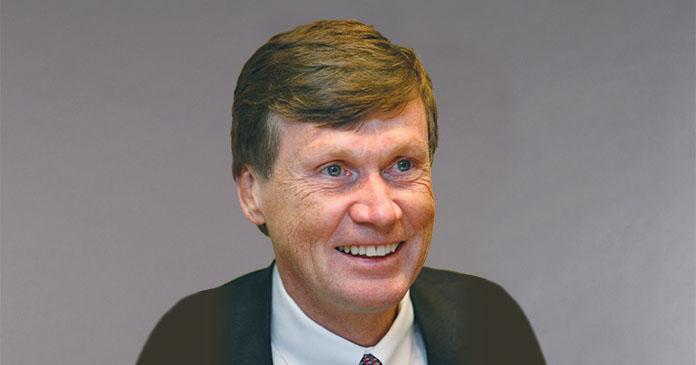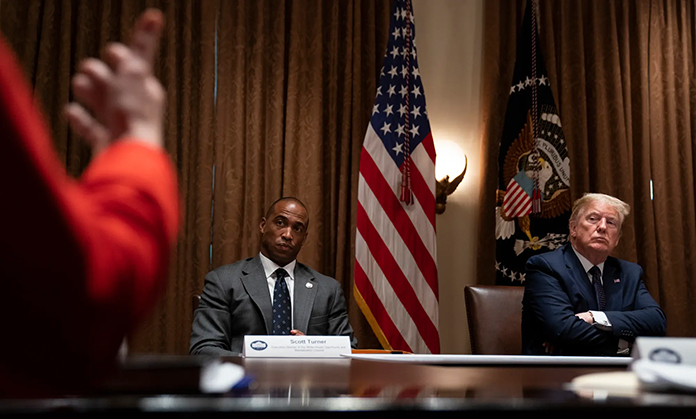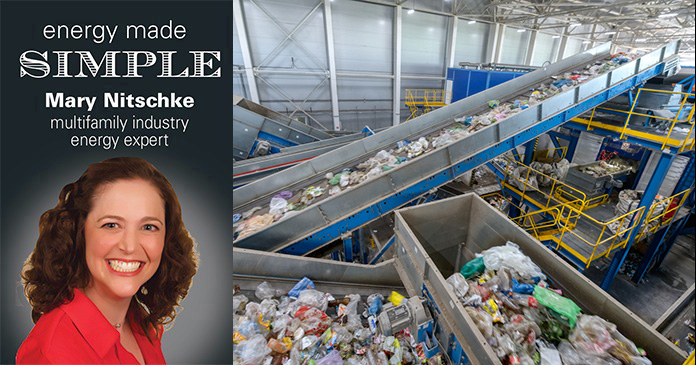
First, Haldeman clarified what Freddie Mac’s business is, and dispelled some common misconceptions. As a player in the secondary market, the company doesn’t deal with families who are applying for mortgages; instead, it buys mortgages from banks and mortgage originators, packages them and issues mortgage-backed securities, which are then offered on the public market. “We do that so there’s a flow of funds, so the originator has more funds that it can re-lend and put out into other mortgages,” he said. “Liquidity, stability and affordability,” are a real mantra for the company, he added. They underscore Freddie Mac’s purpose.
In America’s single-family and multifamily apartment mortgage space, Freddie Mac holds 23 percent of 55 million mortgages. However, Haldeman noted that public perception paints Freddie Mac and fellow mortgage giant Fannie Mae as the primary culprits in the mortgage crisis. “The data suggest the opposite,” he argued. Although 10 percent of all mortgages are at least 90 days overdue and vulnerable to foreclosure, Freddie Mac’s delinquency rate is only 4 percent. “That’s an indication that we’ve done a reasonable job over the years of underwriting, and we’ve done a reasonable job of working with families to keep them in their homes,” he said. Overcoming this negative image was just one of several uphill battles Haldeman had to fight when he arrived on the scene last August.
Besides being blamed for the housing crisis, Freddie Mac had a leadership vacuum. Its 6,000 employees had no CEO, CFO or COO. And there had been significant turnover among senior management. “When I took the job,” Haldeman said, “I was the sixth CEO in six years, and the prior CEO had left the company after being in the job for six months.” In addition, the company owed the government $50 billion it had borrowed at 10 percent interest. “Just to stay even, we had to earn $5 billion,” observed Haldeman, who noted that the company’s situation created a sense of hopelessness among employees.
Effecting significant change was slowed by the layers of approvals needed to carry out a strategy, since Freddie Mac is government-owned and regulated by the Federal Housing Finance Administration (FHFA). At a traditional company, a CEO must win support from a board of directors to carry out major initiatives. At Freddie Mac, however, not only is board approval needed, but also the go-ahead from the FHFA. In addition, for “really significant decisions, the major owner has to be involved—the U.S. Treasury Department.” For compensation decisions, the Obama administration’s “pay czar,” Kenneth Feinberg, must also sign off, and recent public criticism of pay packages in the financial industry makes compensation issues all the more nettlesome. “The louder the noise, the more difficult it will be to get fair compensation,” Haldeman pointed out.
Added to those challenges is the fact that Freddie Mac’s fate is uncertain. The company is still in “conservator-ship,” or under the control of the FHFA – “not too different from being in receivership,” Haldeman said—so climbing out of that $50 billion hole at 10 percent interest is difficult at best. After the federal government proposes a new business model for the company, that plan will be debated in Congress. As a result, Freddie Mac could become a federal agency; it could be broken up or it could be abolished outright. “Think about being an employee of the company and hearing statements like that on a regular basis,” Haldeman noted.
Given all the strife, Haldeman is commonly asked why he agreed to take the reins at Freddie Mac. “First, I thought the mission of Freddie Mac and Fannie Mae was really important, and we ought to keep it together.” The companies already had a strong infrastructure, and employees brought a vast institutional knowledge about the mortgage markets, he added. Haldeman also considered the company’s goal of keeping people in their homes to be vital during a recession. Finally, he thought the job presented “an interesting management challenge: how to energize and motivate 6,000 people to stay the course and get the job done, given all the negatives.”
Creating a template
Haldeman applies the same management principles to any company he joins. “The first day you come in,” he said, “you literally don’t know one person. You’ve got to have a template, some philosophy to bring” that can be applied to an organization and the culture that already exists. Haldeman said his ideal management model has eight necessary ingredients:
- Make integrity and high ethics prerequisites. A lot of business people think there’s a trade-off between ethics and making money, Haldeman said, but “in my experience it’s not that way. Integrity and ethics are a sort of precondition for business success.” He encouraged leaders to establish “a personal brand” that is based on those qualities. When Haldeman was brought in to manage Putnam, the company had “an ethical problem” that ultimately killed the brand. “It cost us billions of dollars” in market value, Haldeman recalled. “If you are contemplating an action and your instinct is to go to the company’s compliance manual, don’t take that action.”
- Create a workplace that’s open, direct, candid and honest. Haldeman emailed all his employees when there was a House Financial Services Committee meeting, saying, “It’s likely they’re going to trash us, so be ready for it.” He faced up to the uncertainty of the next two years, telling staff to focus on what they can do today. “We let employees feel that they know what we’re thinking, what our strategy is.”
- Make sure employees understand the company mission. A person’s job is about more than making money, Haldeman stressed, and “to really motivate people, you need to have them believe that they’re doing something worthwhile.”
- Develop a business plan that all employees can understand and repeat. As an example, Haldeman cited a time at Putnam when morale was low, there was a run on the bank and clients were leaving. He directed employees to think about what the company actually did, that their job was “taking care of other people’s money.” Then he developed a clear, four-step business plan: Reestablish the public trust; bring great investment professionals on board; deliver great investment results and bring funds flowing in with better marketing and distribution.
- Communicate the mission and plan constantly. In one of his weekly dinners with company officers, Haldeman was asked, “So basically what you do is schmooze all day, right?” He accepts that characterization as critically important in his job—to transmit the values, the sense of mission and the business plan, not only to employees, but also to “directors, the regulator, Congress, customers and clients.”
- Give other people autonomy. As a former asset manager, Haldeman said, he felt this was the only way to manage people. “If you want to attract and keep great people at any organization, you’ve got to give them a sense of autonomy, of ownership. The really good people won’t tolerate being micromanaged.”
- Enforce teamwork. Not enforcing it makes for dysfunctional management. Employees know “when a senior team is working together or when they are not aligned. If teamwork stays bad, you’ve got to get rid of some people.”
- Senior managers must spend time walking around. “You can’t stay in your office,” he advised. “Too many CEO operations are cocooned and separated.” Not only does circulating make employees feel more connected to management and the company, in many cases it’s the best way to hear what’s really going on.
Haldeman doesn’t know what the future holds at Freddie Mac. As part of his business plan, he focuses on taking care of its two hugely important jobs right now: maintaining liquidity in the mortgage market to keep things flowing, and keeping people in their homes. Last year, more than 70 prtcent of all mortgages were handled by Freddie Mac and Fannie Mae, up 30 percent from just four years earlier. The companies filled the gap left by the fall-off among private market lenders. To help staunch the bleeding in foreclosures, Freddie Mac has shown forbearance and modified mortgages by lowering interest rates or extending the mortgage from 30 to 40 years, “to allow that monthly payment to be more suitable for the borrower.” Haldeman explained that this is not principal forgiveness, but rate readjustment. Helping the company’s efforts are the government’s Home Affordable Modification Program (HAMP) and Home Affordable Refinance Program (HARP). Typically, a refinance would cover only up to 80 percent of a home’s value, but following massive devaluations in the home sector, HARP now allows refinancing up to 125 percent of the assessed value. Haldeman stressed that this has broadly expanded the number of refinancings Freddie Mac can do.
Also in Freddie Mac’s business plan is achieving compliance under the regulatory protections put in place by the 2002 Sarbanes-Oxley Act, which the company has been trying to do for four years, as well as meeting new federal accounting standards that require companies to “take all the off-balance-sheet assets and put them on the balance sheet,” Haldeman said. That effort involved 900 employees in a $25 million technology project to put 12.5 million mortgages on Freddie Mac’s balance sheet. Finally, Haldeman wants “to do a major restructuring of our infrastructure, our systems “and our business processes to make ourselves much more efficient.”
Author: Consortium of professors at knowledge@wharton, affiliate of University of Pennsylvania, Wharton School of Business














